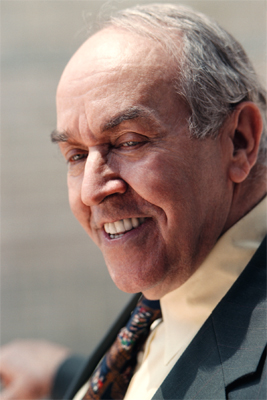Classical music, ballet, musical theater, opera—the acoustician Russell Johnson, who died August 7 at age 83, loved them all. Johnson read about the musical arts voraciously, attended performances regularly, and, as the founder of the 37-year-old acoustics and theater-planning firm Artec Consultants, raised the visibility of acousticians in the design and construction of performance venues.
Johnson relied on more than just his enthusiastic spectatorship to determine the acoustics for some this generation’s most renowned concert and recital halls, theaters, and opera houses. “He was not a fly on the wall,” says Tateo Nakajima, one of Artec’s two managing directors, “he talked and interacted with musicians and conductors. He would work and understand how the sound worked in a room.” As an example of Johnson’s willingness to collaborate with people intimately involved in the making of music, Nakajima points to himself: before joining Artec, he had been an orchestral conductor, including one season at the Vienna State Opera.
To help his performance spaces achieve clear, full sound consistently, Johnson looked back to historical precedent and championed the shoebox auditoriums of older, renowned concert halls. “Surely those who created the beloved concert halls of Europe and Symphony Hall in Boston knew something,” Nakajima explains, “he went back to study those shapes.”
On the other hand, Johnson also pioneered adjustable acoustics systems so that a concert venue could accommodate a modern-day array of performance types. Motorized reflectors and cloth systems, secondary acoustics chambers, and adjustable seating all contribute to acoustical flexibility, and many of his projects included a combination of elements. The Jean Nouvel–designed Concert Hall of Lucerne deploys a 247,000-cubic-foot perimeter control chamber, sound-absorbing curtains, and a two-piece vertically adjustable acoustical canopy in order to host orchestral, choral, and popular music performances. Johnson also created signature elements for specific projects. Rafael Viñoly’s Jazz at Lincoln Center, for instance, features a box-within-a-box setup to eliminate vibration, a slightly canted glass that keeps sound from bouncing into the audience, and a ceiling grid of diffusers.
Nakajima sums up Johnson’s balance of backward glances and innovation: “Artec is one of the most conservative firms in the industry, as well as one of the most innovative.” He adds that, thanks in part to Johnson’s successes, “the industry realized that these facilities really have to be designed from the inside-out.” When it is not working with an architect from day one, Artec often is retained for a project well before an architect-selection process begins.
Beginning in 2002, Nakajima says, Johnson prepared for Artec to carry on after his death. He shifted its management structure to include managing directors such as Nakajima and his colleague Damian Doria, while continuing to serve as chairman of the company. Johnson worked in that capacity until the day before his death.
Johnson is survived by his sister, Barbara Johnson Mansfield, and her three children. His funeral will be held on August 18 in Berwick, Pennsylvania, where he was born, and a memorial service will be held in New York at a later date that has not yet been determined.



Post a comment to this article
Report Abusive Comment